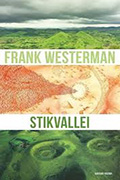Frank Westerman
The study of literary non-fiction through the lens of Frank Westerman's works provides a nuanced understanding of how hybrid genres navigate the complexities of promotion and reception across different cultural contexts. In the following lines, we will explore the dynamics of the Dutch and Spanish literary fields, emphasizing the role of branding, paratexts, and sociological considerations in shaping audience expectations and experiences.
Literary non-fiction (A hybrid genre)

Literary non-fiction occupies a unique space at the intersection of factual reporting and literary artistry. Combining rigorous research with narrative techniques traditionally reserved for fiction, the genre emphasises not only the 'what' but also the 'how' of storytelling.
(Frank Westerman)


Westerman is a Dutch key figure in this genre. His award-winning oeuvre consists of 15 books that have been widely translated into about 20 languages.
His works range from history and sociology to deeply personal narratives, all underpinned by what is known as the 'Method Westerman'. This approach combines meticulous research, a strong personal voice and multiple narrative perspectives, encouraging readers to critically engage with the text rather than passively consume it.
Editorial and sociological dynamics
In the Netherlands, literary non-fiction has become a genre with high symbolic and economic capital. Westerman's work benefits from a robust branding framework that underlines its literary qualities and positions it as 'literature of facts', following in the footsteps of Ryszard Kapuściński. The focus is on narrative style and artistic expression, transcending thematic boundaries.
The reception in Spain, however, paints a different picture. Westerman's works are marketed under different labels - journalism, historical non-fiction and essays - depending on the publisher. This lack of consistency affects how his works are positioned in the book market and, consequently, how they are perceived by readers. Without the cohesive branding that exists in the Dutch context, Spanish publishers often focus on the thematic content of Westerman's works, sidelining their literary and narrative dimensions.




Audience expectations and reception
In the Netherlands, Westerman's books are usually received as multifaceted narratives that invite interpretation and critical engagement. Dutch readers are accustomed to the hybrid nature of his literary non-fiction.
But in Spain, the lack of consistent branding and genre classification leads to mismatched expectations. Readers approach Westerman's works expecting informative essay structures, only to be met with his layered and interpretive style. This misalignment sometimes leads to disappointment, as readers look for definitive answers or linear narratives that his books deliberately do not offer.
The role of paratexts
Elements such as covers, blurbs and promotional material play a crucial role in shaping the reception of works in new markets. In the Dutch context, such paratexts effectively communicate the hybrid nature of Westerman's literary non-fiction and promote its artistic and narrative qualities. In Spain, on the other hand, paratexts tend to focus on the thematic content. This thematic orientation often overshadows the literary qualities that define Westerman's style, contributing to the mismatch between readers' expectations and the text itself. A more strategic use of paratexts would therefore be appropriate to highlight the narrative and stylistic dimensions of literary non-fiction in international markets.
Institutional branding and its challenges

The Dutch Foundation for Literature plays a central role in the promotion of Dutch literature abroad. Since 1997, it has made literary non-fiction (initially categorised as 'Quality Non-Fiction') a special focus area and has supported translations of works characterised by ‘high quality prose’ and ‘innovative treatment of themes’. From 2020, 'Quality Non-Fiction from Holland' has been renamed 'Dutch Non-Fiction', signalling a shift towards inclusivity and international appeal. This shift is in line with broader trends in Dutch literary policy, which is increasingly expanding the scope of eligible non-fiction, including books that might traditionally be classified as scientific outreach or investigative journalism.
Following this evolution, the branding of Westerman’s works through institutional paratexts often emphasizes thematic content over literary style. This may hinder the recognition of his works as literary non-fiction in foreign book markets. While the institutional approach has been successful in expanding the international presence of Dutch non-fiction as a whole, in cases such as Westerman's, the primacy of content over form, and thus the dilution of the intrinsic qualities that distinguish Westerman's storytelling, may influence how his works are received. This highlights the complexity of promoting hybrid genres such as literary non-fiction on a global stage.
Implications for translation and translator training
The challenges highlighted in these lines have significant implications for the profession and the training of literary translators. Translators play a crucial role in mediating between source and target cultures, and their choices and decisions can influence how a work is received in a new context. Understanding the sociological dynamics of literary branding and reception is essential to navigate these complexities effectively.

These considerations should therefore be part of the didactics of literary translation, for example through the Petra-E framework and the PetraNED network. By equipping translators with tools to engage with the socio-cultural dimensions of literary works, educators can enhance the cross-cultural reception of hybrid genres such as literary non-fiction. This approach can help bridge the gap between different literary traditions and foster a more nuanced appreciation of the genre.
Some final remarks
Frank Westerman's work exemplifies the potential and challenges of literary non-fiction in a globalised literary market. His distinctive style, which blends factual evidence with literary techniques, makes him a leading figure in this hybrid genre. However, inconsistencies in how his works are branded and marketed in different contexts reveal the critical role of editorial and institutional dynamics in shaping reception.
As a result, there is a need for coherent branding strategies that are reflective of the intrinsic qualities of his work. By emphasising both thematic relevance and narrative artistry, publishers, translators and institutions can better support the internationalisation of the genre. Ultimately, the success of literary non-fiction depends on its ability to navigate the intricacies of cross-cultural communication while remaining true to its hybrid nature.
(Goedele de Sterck)
References
De Sterck, Goedele: Cap. 2. La no ficción literaria a través del prisma de los actores del engranaje editorial. In: Santana López, B.; De Sterck, Goedele (eds.) La traducción de la no ficción literaria: de los hechos a la literatura y de la literatura a los hechos. Granada: Comares, 2022.
